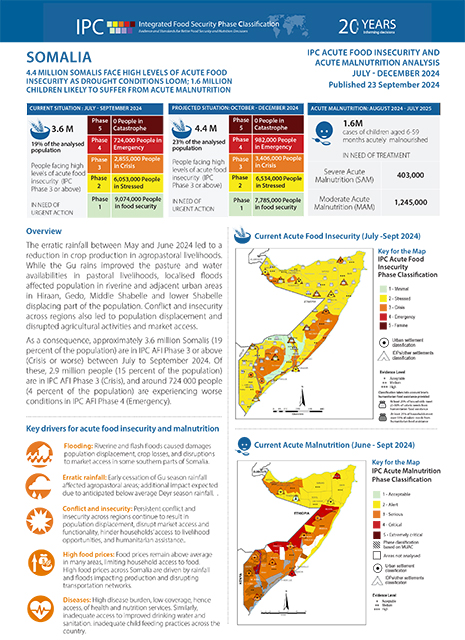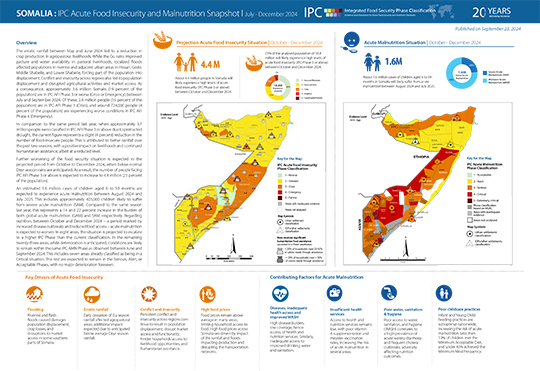
- © Unicef Somalia
SOMALIA: About 4.4 million experiencing high levels of acute food insecurity; 1.6 million children likely to suffer from acute malnutrition
The erratic rainfall between May and June 2024 led to a reduction in crop production in agropastoral livelihoods. While the Gu rains improved pasture and water availability in pastoral livelihoods, localized floods affected populations in riverine and adjacent urban areas in Hiraan, Gedo, Middle Shabelle, and Lower Shabelle, forcing parts of the population to be displaced. Conflict and insecurity across regions also led to population displacement and disrupted agricultural activities and market access. As a consequence, approximately 3.6 million Somalis (19 percent of the population) are in IPC AFI Phase 3 or worse (Crisis or Emergency) between July and September 2024. Of these, 2.9 million people (15 percent of the population) are in IPC AFI Phase 3 (Crisis), and around 724,000 people (4 percent of the population) are experiencing worse conditions in IPC AFI Phase 4 (Emergency).
In comparison to the same period last year, when approximately 3.7 million people were classified in IPC AFI Phase 3 or worse due to protracted drought, the current figure represents a slight (4 percent) reduction in the number of food-insecure people. This is attributed to better rainfall over the past two seasons, which had a positive impact on livelihoods and continued humanitarian assistance, albeit at a reduced level.
Further worsening of the food security situation is expected in the projected period from October to December 2024, when below-normal Deyr season rains are anticipated. As a result, the number of people facing IPC AFI Phase 3 or worse is expected to increase to 4.4 million (23 percent of the population).
An estimated 1.6 million cases of children aged from 6 to 59 months are expected to experience acute malnutrition between August 2024 and July 2025. This includes approximately 403,000 children likely to suffer from severe acute malnutrition (SAM). Compared to the same season last year, this represents a 14 and 22 percent increase in the burden of both global acute malnutrition (GAM) and SAM, respectively. Regarding nutrition, between October and December 2024 – a period marked by increased disease outbreaks and reduced food access – acute malnutrition is expected to worsen. In eight areas, the situation is projected to escalate to a higher IPC Phase than the current classification. In the remaining twenty-three areas, while deterioration is anticipated, conditions are likely to remain within the same IPC AMN Phase as observed between June and September 2024. This includes seven areas already classified as being in a Critical situation. The rest are expected to remain in the Serious, Alert, or Acceptable Phases, with no major deterioration foreseen.
Join our mailing list


